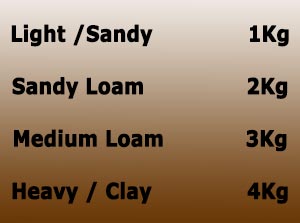Lime can be beneficial to the vegetable garden but before using it you need to test the pH of the soil to determine whether it is acid or alkaline. Acid soil can be made more alkaline by the addition of garden lime. Certain plants prefer acidic soils but most vegetables like a slightly alkaline soil.
pH is measured on a scale of 1-14. Neutral soil is pH 7. Above this is alkaline and below is acid. A soil testing kit can measure your soil pH.
Once you know the pH of your soil, you can add lime to your garden to make an acid soil more alkaline. This needs to be done gradually through several small top dressings over a period of time. If you apply too much lime to your garden in one go, it will scorch roots.
Garden lime will gradually wash out of the soil. Composts and manures will also make soil more acidic, so ground will almost always benefit from the addition of lime to correct the balance.
Studies have shown that adding lime to chalky soil can cause nutrient deficiencies far quicker than other soil types, so a raised bed system with imported soil should be considered in this situation where the soil can be improved with regular additions of organic matter and lime.
Lime should be added to the vegetable garden 6-8 weeks before sowing. I usually lime in the early spring.
Do not apply garden lime at the same time as manure because the two react together, producing ammonia gas and releasing precious nitrogen from the soil.
A good regime to follow is to manure beds that will grow potatoes and other root crops in the autumn, and lime beds in the spring that are going to be growing brassicas. Do not lime every year, once every 3 or 4 years in line with your crop rotation plan is sufficient. Using lime within a crop rotation plan ensures that you get the most benefit from your plot and helps prevent a build up of soil pests and diseases.
Wood ash can also be beneficial to the vegetable garden since it has a liming effect but this is covered on a separate page: Wood Ash in the Vegetable Garden

This will depend largely on your soil type. Heavy, clay soil requires more lime than light, sandy soil. The following table provides a rough guide of how much lime to apply to raise the pH of your soil by one unit:
Amounts given are per 100m2 (so for example a 10m x 10m plot) for different soil types:
Garden lime can be bought in different forms and there is often confusion over which one to use. All of them can in fact be used but the higher quality types of lime are more expensive and they will last for longer.
- Hydrated Lime
Commonly available in builders merchants for adding to concrete. This can be used on the garden but will need replacing annually.
- Slaked Lime
Usually sold in garden centres as ‘garden lime’ and is readily available. Slaked lime will last longer than hydrated lime.
- Dolmite Lime or Ground Limestone
The most expensive type of lime but has the advantage of lasting for several years. If you don’t want to be adding lime regularly then this is a good choice.
